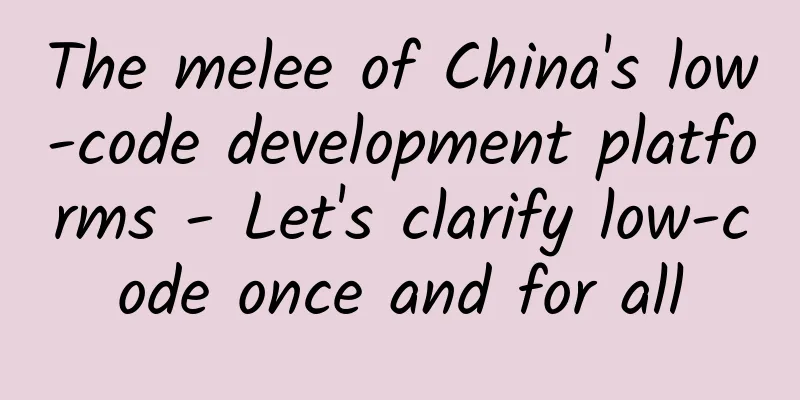The melee of China's low-code development platforms - Let's clarify low-code once and for all

|
Today we will talk about low code in a language that the public can understand. In the past two years, "low code" has been an absolute hot topic, both in terms of capital and the attention of corporate IT departments. Various low-code companies have emerged in the Internet circle overnight. What exactly is low code? Is low code a new technology? What value can low-code development bring to enterprises? How can enterprises use low code? Which platforms are truly low-code and which are just trying to fish in troubled waters to take advantage of the hot spots? Let's make it clear all at once today. What exactly is low-code? Why do enterprises need low-code?
"Low-code" can be understood literally as "writing less code than normal application development". Let's sort out the value of the "low-code" development platform: "CloudNative cloud-native applications" can be developed "on the cloud"; How to develop on the cloud? Use visualization or even WYSIWYG, through drag-and-drop development; What kind of cloud-native applications can be developed using drag-and-drop visualization on the cloud? "Personalized applications" that are mainly mobile-oriented need to cover back-end and PC management capabilities. What are the characteristics of the developed applications? They are often peripheral applications initiated by business departments, which need to be launched quickly and whose overall application life cycle does not exceed one year. To sum up, the mainstream definition of low-code is: cloud-native applications that can be quickly developed on the cloud using visual drag-and-drop and a small amount of code to meet the needs of small and medium-sized applications mainly on mobile terminals initiated by corporate business departments. This cloud platform is usually called a low-code development platform. Now that we understand what low-code is, we can better guide enterprises to use low-code. Suggestion 1: "If you want to develop an OA or ERP, you should not use low code" As early as 2016, Gartner released a report on three classification models of enterprise software. The "Speed Tiered Application Report" divided enterprise applications into three types: infrastructure (such as ERP), differentiation (such as CRM), and innovation (such as various mobile applications). The first two are areas covered by traditional enterprise IT, and are inherent IT models maintained and dominated by traditional IT personnel. As the degree of enterprise Internetization becomes deeper and deeper, the demand for the third type of innovative applications is growing rapidly, that is, non-traditional IT-led applications initiated by business departments. These applications have the characteristics of "Internet attributes", "on the cloud", "short launch cycle", "experimental", "short life cycle", "uncertain demand", and "a hot potato that traditional IT departments are unwilling to take on". The core of the emergence of low-code platforms is to meet these development needs, rather than to grab the market of OA, CRM or even ERP. Suggestion 2: Enterprises need low-code developers. Of course, they cannot rely on the business department to develop low-code, but they cannot rely solely on the inherent IT department. When low-code started to become popular abroad, there was a beautiful vision that citizen developers, i.e. business personnel without technical background, could use low-code platforms to develop innovative enterprise applications. However, the reality is very bleak. Even if they have the advantage of English and can understand computer code, it is impossible for business personnel to develop applications. After all, low-code is not no-code, and there are still considerable coding and technical requirements. It sounds reasonable to let the IT department use low-code development platforms to help business departments develop innovative applications, but in reality there is a big paradox, because the IT department already has many mature tools and systems that can improve the development efficiency of programmers, so there is no need to use a new one. Moreover, "serious" programmers do not want to use a set of tools that "seem to work for themselves but actually revolutionize their careers" so that their development skills cannot be improved. The needs of business departments are realistic, and it is also true that the existing IT team is unwilling to take on these peripheral innovative applications. For this reason, low-code development platforms came into being, and low-code platforms often "use the business department's own budget to find new personnel (internal or external) to meet the development needs of these innovative applications." Therefore, low-code development platforms must have a large number of mature developers, and building their own "low-code development ecosystem" is the core task. In this chaotic world of low-code, how do we distinguish between the good guys and the bad guys? In fact, it is very interesting. If you study the leading low-code companies abroad, you will find that all leading companies are very "old" companies, and there are basically no newly established companies. These companies used to have their own core capabilities. For example, Outsystems and Mendix used to mainly do BPM (workflow), Kony used to mainly do MADP (mobile development platform), and the core of Microsoft and SAP's low-code development is the reorganization of the previous aPaaS and MADP. It can be seen that foreign low-code development platforms are not brand-new innovative technologies, but new models based on existing technology foundations. That is, the mainstream LowCode platform is formed by combining the process and visualization based on BPM, the componentized cloud native of aPaaS, and the rapid development of cross-platform mobile Internet innovative applications by MADP. Whether a low-code company has at least one of the three important genes of BMP, MADP, and aPaaS is an important criterion for judging whether the platform is a low-code company. "Low code" means "writing less code than normal application development". However, not all development methods that can save code can be called "low code". True low code must have some necessary characteristics. Looking at the definitions of their products by well-known foreign companies such as Outsystems, Mendix, Appian, and Kony, which are leaders in Forrester and Gartner's low-code evaluation, the core elements that low-code development platforms must have are called "3+1": 3 capabilities: visualization (drag-and-drop), MADP (mobile first), and aPaaS (cloud development environment). 1 must: A supporting ecosystem (mature developers and the ability to connect to other clouds or internal enterprise systems). Of course, many people will also talk about concepts such as "model-driven", "form-driven", "middle platform capabilities", "continuous integration", etc. These are all possible factors, not non-essential factors. Different low-code development platforms have different focuses, so I won't go into details here. In short, remembering 3+1 will easily distinguish between "real" and "fake" low-code development platforms. [Editor: Wang Xueyan TEL: (010) 68476606] |
<<: Say “no” to excessive permissions requested by mobile apps
>>: How do Tencent designers optimize designs? This case study is so vivid!
Recommend
Marketing promotion plan: New media marketing hot calendar in May!
Whether it is new media, marketing, event plannin...
Baoding has built 45 green belts to create a model city for "smart transportation" in the north
On December 12 , the Baoding Traffic Congestion Di...
Which way to the moon?
Recently, the "Artemis 1" has come to a...
WeChat users, please take note! These five actions may cause your account to be permanently blocked
With the continuous development and progress of s...
International Maritime Day丨How to sail steadily when encountering strong winds and waves? Experts say→
The "strong winds and waves" mentioned ...
The title of the earliest "Zhejiang Man" has changed? A stone tool reveals the "survival revelation" of millions of years ago
When talking about the earliest human life in Zhe...
Are the bamboo shoots eaten by giant pandas actually poisonous?
When it comes to bamboo shoot experts, the giant ...
Nokia to return to mobile phone market as early as next year
[[132243]] Four years ago, then-Nokia CEO Stephen...
WeChat mini-program games are very popular. What scenarios are they not suitable for at this stage?
Recently, WeChat Mini Programs have once again ma...
An Shihao appointed head of Volkswagen North American sales
According to foreign media reports, Volkswagen Gr...
My personal mini program fails the review. How can I avoid the mini program being rejected?
Q: My personal mini program fails the review. How...
Is the customization cost of Jinzhong Wood Mini Program high? Jinzhong Timber Mini Program Customization Cost and Process
How much does it cost to customize the Jinzhong W...
Four steps of community operation: Taking the operation of King of Glory group as an example
When operating a community , the following steps ...
The most powerful Android virus outbreak in history, effective on 15,000 models
[[150475]] Many years ago, viruses (programs) wer...
Can ordinary masks be transformed into N95 masks by tying a knot? Is it really that magical?
[This issue's rumor]: Recently, a video title...









